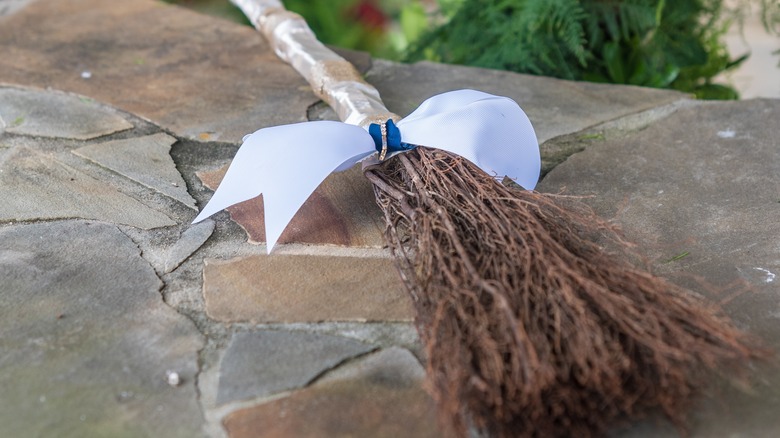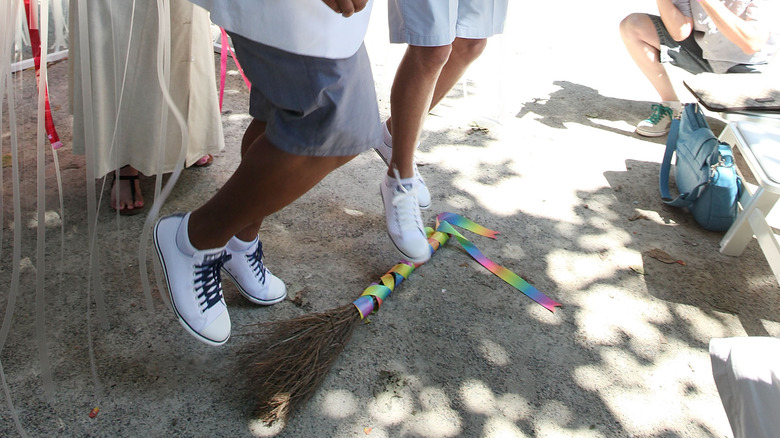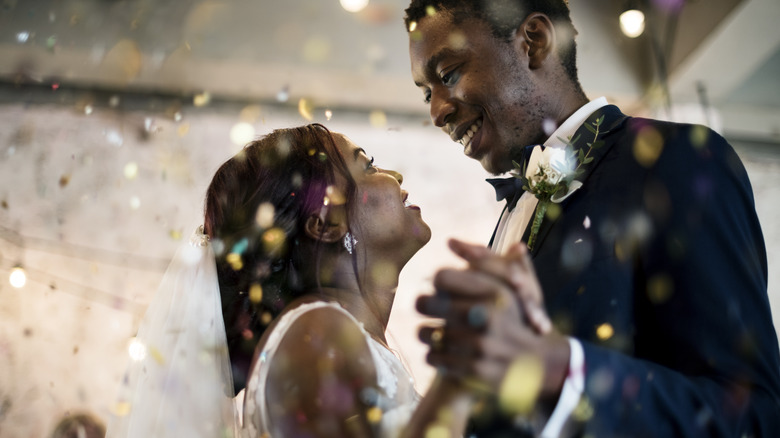The History Of Jumping The Broom At Weddings
In some parts of the world, wedding receptions often involve guests drinking one too many cocktails at the open bar, crying over how beautiful the bride looks, and pulling a muscle getting down to the "Cha Cha Slide." Although, many couples around the world participate in wedding traditions that celebrate their heritage and are passed down through generations.
Some of our favorite traditions happen during the wedding ceremony, where the newlyweds vow to love each other forever and seal it with a kiss. While ceremonies might look different all over the world, they all have one thing in common: we need a box of tissues by the end of it. One of the most memorable traditions is the jumping of the broom. The history of this ceremonial act can be traced back hundreds of years and is present in many different cultures, per Oprah Daily.
Brides define jumping the broom as "a traditional act performed at some Black weddings. After vows are exchanged, the newlyweds hold hands and jump over a broom to seal the union." But, what is the full history of the jumping the broom wedding tradition?
The exact origins of jumping the broom isn't clear
Wedding expert Nicole Harris tells Brides, "After exchanging vows and saying I do,' the officiant will either provide a prayer, poem, or a brief explanation of the meaning of jumping the broom. The broom is then placed on the ground and the newlyweds jump over it."
This practice is believed to bless the marriage and the first steps of the couple's union. Brooms have major significance in West African culture, where some argue the tradition came from. It was believed that waving a broom over a newly married couple's heads would ward off evil spirits. according to Brides. Nowadays, couples aren't as concerned with evil spirits ruining their day, but the act of jumping the broom remains for its significant cultural ties.
The origins of this tradition aren't exact, however. Some people claim that the tradition of jumping the broom was practiced by the Roma people of Wales first, symbolizing the union of two people when they weren't allowed to be married by the church. Oprah Daily reports that "the tradition of jumping the broom traveled from Britain to the colonies." African Americans may have adapted this tradition during slavery to symbolize their union when they weren't allowed to legally get married (via Insider). This ceremony was captured in the 1977 television series "Roots," renewing the tradition in many African American families who felt it was a significant way to honor their history (via Oprah Daily).
Wedding brooms are sometimes passed down through generations
Not just any old household broom will cut it at the altar. Brides report that the broom is usually "three feet long and has a wooden handle with natural bristles." Brides and grooms are encouraged to decorate the broom and personalize it to match their perfect aesthetic. After the wedding, many couples choose to keep the broom and display it in their home as a symbol of unity. When the time comes for the next family member to get married, the couple gives the broom to the newlyweds, and the tradition continues. According to Insider, brooms have stayed in families for generations as a special heirloom and reminder of their culture and history (it can also be your "something old" or your "something borrowed").
Some couples choose to incorporate the tradition into their ceremony to honor their ancestors, while others decide to skip it. Nicole Harris tells Brides, "When African Americans incorporate jumping the broom, it is to pay homage to their culture and legacy." Those who choose not to jump the broom may argue it is "a relic of slavery" and feel the tradition is a bit outdated, according to Insider. Just like any other wedding tradition, it is completely up to the couple what they choose to participate in on their wedding day.


